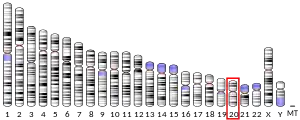5'-3' exoribonuclease 2
5'-3' Exoribonuclease 2 (XRN2) also known as Dhm1-like protein is an exoribonuclease enzyme that in humans is encoded by the XRN2 gene.[5]
The human gene encoding XRN2 shares similarity with the mouse Dhm1 and the yeast's Dhp1 (Schizosaccharomyces pombe) or RAT1 (Saccharomyces) genes. The yeast gene is involved in homologous recombination and RNA metabolism, such as RNA synthesis and RNA trafficking and termination.[6] Complementation studies show that Dhm1 has a similar function in mouse as Dhp1.
Function
Human XRN2 is involved in the torpedo model of transcription termination.[7]
The C. elegans homologue, XRN-2, is involved in the degradation of certain mature miRNAs and their dislodging from miRISC miRNAs.[8]
In yeast, the Rat1 protein has been shown to also be involved in the torpedo transcription termination model. When a polyadenylation site has been detected on the nascent RNA and cleaved by the RNA polymerase II, the Rtt103 factor recruits Rat1 and attaches it to free end. The exonuclease activity of Rat1 degrades the RNA strand and halts transcriptions upon catching up to the polymerase.[6]
See also
References
- GRCh38: Ensembl release 89: ENSG00000088930 - Ensembl, May 2017
- GRCm38: Ensembl release 89: ENSMUSG00000027433 - Ensembl, May 2017
- "Human PubMed Reference:". National Center for Biotechnology Information, U.S. National Library of Medicine.
- "Mouse PubMed Reference:". National Center for Biotechnology Information, U.S. National Library of Medicine.
- Zhang M, Yu L, Xin Y, Hu P, Fu Q, Yu C, Zhao S (July 1999). "Cloning and mapping of the XRN2 gene to human chromosome 20p11.1-p11.2". Genomics. 59 (2): 252–4. doi:10.1006/geno.1999.5866. PMID 10409438.
- David Tollervey (November 2004). "Termination by torpedo". Nature. 432 (7016): 456–457. doi:10.1038/432456a. PMID 15565140. S2CID 6823163.
- West S, Gromak N, Proudfoot NJ (November 2004). "Human 5' --> 3' exonuclease Xrn2 promotes transcription termination at co-transcriptional cleavage sites". Nature. 432 (7016): 522–5. Bibcode:2004Natur.432..522W. doi:10.1038/nature03035. PMID 15565158. S2CID 4365304.
- Chatterjee S, Grosshans H (September 2009). "Active turnover modulates mature microRNA activity in Caenorhabditis elegans". Nature. 461 (7263): 546–9. Bibcode:2009Natur.461..546C. doi:10.1038/nature08349. PMID 19734881. S2CID 4414841.
External links
- Human XRN2 genome location and XRN2 gene details page in the UCSC Genome Browser.
Further reading
- Lehner B, Sanderson CM (2004). "A protein interaction framework for human mRNA degradation". Genome Res. 14 (7): 1315–23. doi:10.1101/gr.2122004. PMC 442147. PMID 15231747.
- Deloukas P, Matthews LH, Ashurst J, et al. (2001). "The DNA sequence and comparative analysis of human chromosome 20". Nature. 414 (6866): 865–71. Bibcode:2001Natur.414..865D. doi:10.1038/414865a. PMID 11780052.
- Beausoleil SA, Villén J, Gerber SA, et al. (2006). "A probability-based approach for high-throughput protein phosphorylation analysis and site localization". Nat. Biotechnol. 24 (10): 1285–92. doi:10.1038/nbt1240. PMID 16964243. S2CID 14294292.
- Lu Y, Liu P, James M, et al. (2010). "Genetic variants cis-regulating Xrn2 expression contribute to the risk of spontaneous lung tumor". Oncogene. 29 (7): 1041–9. doi:10.1038/onc.2009.396. PMC 6019621. PMID 19915612.
- Lejeune F, Li X, Maquat LE (2003). "Nonsense-mediated mRNA decay in mammalian cells involves decapping, deadenylating, and exonucleolytic activities". Mol. Cell. 12 (3): 675–87. doi:10.1016/S1097-2765(03)00349-6. PMID 14527413.
- Wiemann S, Weil B, Wellenreuther R, et al. (2001). "Toward a catalog of human genes and proteins: sequencing and analysis of 500 novel complete protein coding human cDNAs". Genome Res. 11 (3): 422–35. doi:10.1101/gr.GR1547R. PMC 311072. PMID 11230166.
- Yang XC, Sullivan KD, Marzluff WF, Dominski Z (2009). "Studies of the 5' exonuclease and endonuclease activities of CPSF-73 in histone pre-mRNA processing". Mol. Cell. Biol. 29 (1): 31–42. doi:10.1128/MCB.00776-08. PMC 2612496. PMID 18955505.
- Olsen JV, Blagoev B, Gnad F, et al. (2006). "Global, in vivo, and site-specific phosphorylation dynamics in signaling networks". Cell. 127 (3): 635–48. doi:10.1016/j.cell.2006.09.026. PMID 17081983. S2CID 7827573.
- Scherl A, Couté Y, Déon C, et al. (2002). "Functional proteomic analysis of human nucleolus". Mol. Biol. Cell. 13 (11): 4100–9. doi:10.1091/mbc.E02-05-0271. PMC 133617. PMID 12429849.
- Kaneko S, Rozenblatt-Rosen O, Meyerson M, Manley JL (2007). "The multifunctional protein p54nrb/PSF recruits the exonuclease XRN2 to facilitate pre-mRNA 3' processing and transcription termination". Genes Dev. 21 (14): 1779–89. doi:10.1101/gad.1565207. PMC 1920172. PMID 17639083.
- Gerhard DS, Wagner L, Feingold EA, et al. (2004). "The status, quality, and expansion of the NIH full-length cDNA project: the Mammalian Gene Collection (MGC)". Genome Res. 14 (10B): 2121–7. doi:10.1101/gr.2596504. PMC 528928. PMID 15489334.
- Ota T, Suzuki Y, Nishikawa T, et al. (2004). "Complete sequencing and characterization of 21,243 full-length human cDNAs". Nat. Genet. 36 (1): 40–5. doi:10.1038/ng1285. PMID 14702039.
- Gromak N, West S, Proudfoot NJ (2006). "Pause sites promote transcriptional termination of mammalian RNA polymerase II". Mol. Cell. Biol. 26 (10): 3986–96. doi:10.1128/MCB.26.10.3986-3996.2006. PMC 1488997. PMID 16648491.
- Andersen JS, Lam YW, Leung AK, et al. (2005). "Nucleolar proteome dynamics". Nature. 433 (7021): 77–83. Bibcode:2005Natur.433...77A. doi:10.1038/nature03207. PMID 15635413. S2CID 4344740.
- Li J, Zheng H, Ji C, et al. (2005). "A novel splice variant of human XRN2 gene is mainly expressed in blood leukocyte". DNA Seq. 16 (2): 143–6. doi:10.1080/10425170500066771. PMID 16147866. S2CID 35865401.
- Mammalian Gene Collection Program Team; Strausberg, R. L.; Feingold, E. A.; Grouse, L. H.; et al. (2002). "Generation and initial analysis of more than 15,000 full-length human and mouse cDNA sequences". Proceedings of the National Academy of Sciences. 99 (26): 16899–16903. Bibcode:2002PNAS...9916899M. doi:10.1073/pnas.242603899. PMC 139241. PMID 12477932.
- Beausoleil SA, Jedrychowski M, Schwartz D, et al. (2004). "Large-scale characterization of HeLa cell nuclear phosphoproteins". Proc. Natl. Acad. Sci. U.S.A. 101 (33): 12130–5. Bibcode:2004PNAS..10112130B. doi:10.1073/pnas.0404720101. PMC 514446. PMID 15302935.
External links
- XRN2+protein,+human at the U.S. National Library of Medicine Medical Subject Headings (MeSH)



